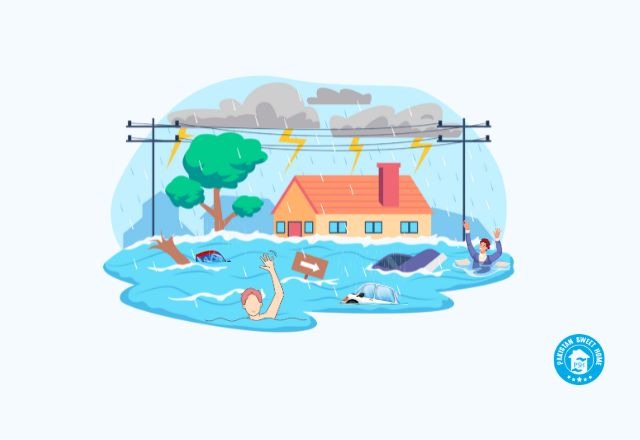Floods in Pakistan aren’t rare, they’re recurring disasters that leave behind shattered homes, broken communities, and displaced families.
For many, the floodwaters wash away more than possessions, they take away security, education, and peace of mind.
The cycle keeps repeating!
Each year, lives are disrupted, and the long-term impact deepens. Without sustainable solutions, the same pain resurfaces with every monsoon.
But this crisis can be managed. Through improved infrastructure, better awareness, and collective action, it’s possible to reduce the damage and protect vulnerable communities.
Let’s unpack what’s driving these floods, how they affect real lives, and what steps can lead to lasting change.
History of Floods in Pakistan - An Overview
Pakistan has experienced 29 major floods since gaining independence.
The first flood hit in 1950, with subsequent floods occurring in 1955, 1956, 1957, 1959, 1973, 1975, 1976, 1977, 1978, 1981, 1983, 1984, 1988, 1992, 1994, and 1995.
Since 2010, the country has faced flooding almost every year. This highlights the increasing frequency and severity of this natural disaster.
Here are the historical flood damages in Pakistan from 1954 to 2014:
Year | Direct Losses (US$ million) 1US$=86PKRs | Lost Lives (number) | Affected Villages (number) | Flooded Area (km2) |
1950 | 488 | 2,190 | 10,000 | 17,920 |
1956 | 319 | 160 | 11,609 | 74,406 |
1957 | 301 | 83 | 4,498 | 16,003 |
1959 | 234 | 88 | 3,902 | 10,424 |
1973 | 5,134 | 474 | 9,719 | 41,472 |
1975 | 684 | 126 | 8,628 | 34,931 |
1976 | 3,845 | 425 | 18,390 | 81,920 |
1977 | 338 | 848 | 2,185 | 4,657 |
1978 | 2,227 | 393 | 9,199 | 30,597 |
1981 | 299 | 82 | 2,071 | 4,191 |
1983 | 135 | 39 | 643 | 1,882 |
1984 | 75 | 42 | 251 | 1,093 |
1988 | 858 | 508 | 100 | 6,144 |
1992 | 3,010 | 1,008 | 13,208 | 38,758 |
1994 | 843 | 431 | 1,622 | 5,568 |
1995 | 376 | 591 | 6,852 | 16,686 |
2010 | 10,000 (@1US$=86 PKR) | 1,985 | 17,553 | 38,600 |
2011 | 3,730 (@1US$=94 PKR) | 516 | 38,700 | 27,581 |
2012 | 2,640 (@1US$=95 PKR) | 571 | 14,159 | 4,746 |
2013 | 2,000 (@1US$=98 PKR) | 333 | 8,297 | 4,483 |
2014 | 500 (@1US$=100.9 PKR) | 367 | 4065 | 9779 |
2022 | 1,739 | 12300 | 2.8 million | 75,000 |
Source: 2015-Annual Flood Report of Federal Flood Commission, Islamabad.
Pakistan Flood Summary (2023–2025)
Pakistan has witnessed severe flooding each year from 2023 to 2025, affecting lives, infrastructure, and livelihoods nationwide. The table below highlights the scale and impact of these recurring disasters.
Year | Estimated Fatalities | Injuries Reported | Most Affected Areas | Key Highlights |
2023 | 150+ | 250+ | Sindh, Balochistan, KP, South Punjab | Heavy monsoon rains triggered flash floods and windstorms; widespread displacement |
2024 | 380+ | 500+ | Gilgit-Baltistan, KP, Sindh, Balochistan | Cross-border flooding events; major infrastructure damage and economic disruption |
2025 | 150+ | 100s | Punjab, KP, Balochistan, AJK, Islamabad Zone | Record-breaking rainfall in Chakwal and Rawalpindi led to dam overflows and evacuations |
Source:
- 2023 Pakistan Flood figures are based on NDMA and media reports between March and July 2023
- 2024 Pakistan Flood data comes from the Afghanistan–Pakistan flood reports running March–September 2024
- 2025 Pakistan Flood fatalities/injuries are from the current 2025 Pakistan floods overview
Causes of Floods in Pakistan
Understanding the causes behind Pakistan's recurring floods is crucial to addressing the problem effectively.
Let’s explore the various factors that contribute to this devastating phenomenon.
1. Environmental Causes
Pakistan's natural landscape and climate make it particularly vulnerable to floods. The monsoon season, occurring between July and August brings heavy rains that can overwhelm rivers and dams.
Additionally, the melting of glaciers and snow caps in the northern mountains increases water flow in rivers. This leads to more frequent and severe floods.
2. Human Causes
Human activities have significantly worsened the flood situation in Pakistan. Rapid and unplanned urban growth has led to the expansion of cities without proper drainage systems.
This causes water to accumulate during heavy rains. Poor land management and building in flood-prone areas further increase the risk of flooding.
3. Deforestation
The widespread cutting down of trees, especially in hilly areas, has a direct impact on flooding.
Trees are essential for holding soil in place and absorbing water. When forests are cut down, the land can't hold onto water as well. This causes more water to flow away during rains, leading to flash floods and landslides.
4. Improper Waste Disposal
Throwing garbage into the streets and drainage systems is a common issue in many urban areas of Pakistan. This waste blocks drains, preventing water from flowing freely. As a result, during heavy rains, the blocked drains cause streets and low-lying areas to flood.
5. Inadequate Infrastructure
Pakistan's outdated and insufficient infrastructure also contributes to the severity of floods. Many dams, levees, and drainage systems are poorly maintained or simply not capable of handling large amounts of water.
The lack of a flood management system exacerbates the damage caused by floods.
6. Climate Change
Climate change is increasingly playing a role in the frequency and intensity of floods in Pakistan.
The country is facing more extreme weather events, including uncertain monsoon rains and rapid glacier melting. These changes are expected to make floods even more common and severe in the future.
Impacts of Floods in Pakistan
The disastrous impacts of floods in Pakistan are far-reaching and affect millions of people across the country.
Here are the key consequences:
Loss of Lives
Floods have claimed thousands of lives over the years, with many people losing their lives due to drowning, and landslides. The lack of timely help and rescue operations often worsens the situation.
Destruction of Homes
Floodwaters often sweep away entire villages, leaving thousands of families homeless. In urban areas, homes are inundated, causing significant damage to property and displacing countless people.
Agricultural Damage
Floods severely impact Pakistan's agriculture, destroying crops, livestock, and agricultural infrastructure. This not only leads to food shortages but also affects the livelihoods of farmers, pushing them further into poverty.
Urban Flooding
In cities, poor drainage systems and unplanned urbanization result in severe urban flooding. Streets and homes are submerged, transportation is disrupted, and essential services are ended.
The accumulation of water also causes health risks, leading to the spread of waterborne diseases.
Economic Losses
The economic impact of floods in Pakistan is staggering, with billions of rupees lost in damage to infrastructure, homes, businesses, and agriculture. The long-term economic impact can be felt in the form of slower economic growth and increased poverty.
Displacement of Communities
Floods force people to leave their homes and seek refuge in temporary shelters or relief camps. Displaced communities often face challenges such as lack of food, clean water, and medical care.
Outbreak of Diseases
After floods, stagnant water and poor sanitation create breeding grounds for various diseases. Waterborne diseases like cholera, typhoid, and diarrhea become common, while mosquito-borne illnesses such as malaria and dengue fever spread quickly.
The lack of safe drinking water and proper hygiene facilities further increases the health crisis.
Environmental Degradation
Floods contribute to soil erosion, loss of fertile land, and degradation of natural habitats. The long-term environmental impact includes reduced agricultural productivity and loss of biodiversity. These pressing challenges have drawn the attention of many philanthropic organizations dedicated to climate resilience and environmental recovery.
How to Prevent Floods in Pakistan?
Preventing floods in Pakistan requires a complete plan that includes actions from both the government and individuals.
Let’s explore how individuals and governments can play a crucial role in flood prevention.
1. Individual Level
Here’s how personal efforts can make a significant difference in preventing and mitigating the effects of floods.
Clear Debris from Drains and Ditches
Keep leaves, mulch, and other debris away from your yard and drainage paths. Regularly rake leaves and dispose of them properly, especially if you live near many trees.
Check and clean nearby storm drains to prevent blockages, and contact your local water or sewer department if you encounter severe clogs.
Maintain Downspouts and Gutters
Clean your gutters and downspouts at least once a year, or more frequently if you have many trees around your home. Use a leaf blower, gloves, or a high-pressure water hose to remove debris. Hiring a professional to handle this can also be a good option.
Improve Home Grading and Drainage
Observe how rainwater accumulates around your home and ensure the ground slopes away from your foundation. You may need to add soil or sod to improve grading. Installing proper drainage systems can also help manage water flow during heavy storms.
Seal Foundation Cracks and Openings
Inspect your foundation annually and seal any cracks with masonry or mortar caulk. Ensure that doors, windows, and utility penetrations are properly sealed to prevent water ingress.
Grow Trees
Planting trees around your property can help absorb excess water and reduce runoff, contributing to overall flood prevention. Even small efforts can make a difference, and every preventive measure is an act of kindness toward your community and the environment.
2. Government Initiatives
Here are the key government initiatives designed to tackle flood prevention and management.
Early Warnings and Updated Forecasts
The government should provide timely and accurate weather forecasts and flood warnings to help residents prepare and respond effectively. This includes updating information about potential hazards and implementing advanced warning systems.
Cleanliness and Maintenance
Ensure that public drainage systems and waterways are regularly cleaned and maintained to prevent blockages and reduce flood risk. Proper waste management practices should be promoted to keep drains and sewage systems clear.
Flood management strategies
The government of Pakistan has created a complete plan to deal with flooding. This plan is part of the Pakistan Flood Response and uses integrated flood management strategies.
These strategies are explained in the 10-year National Flood Protection Plan-IV (2015-2025). This plan fixes the problems found in earlier flood protection efforts. It includes both structural and non-structural measures to prevent and manage floods effectively.
It emphasizes the need for collaboration among various stakeholders. This includes local communities, flood-affected individuals, funding organizations, NGOs, and government departments at national, provincial, and local levels.
Here’s a detailed overview of the flood management strategies outlined in the National Flood Protection Plan-IV:
Strategy | Options | Categories |
Reducing Floods | Watershed Management | Non-Structural Measure |
Dams and Reservoirs | Structural and Non-Structural Measure |
High Flow Diversions | Structural and Non-Structural Measure |
Channel Improvement | Structural and Non-Structural Measure |
Reducing Susceptibility to Damage | Flood Forecasting and Early Warning | Non-Structural Measure |
Strengthening of Existing Rain and River Gauging Network | Non-Structural Measure |
Floodplain Regulation | Non-Structural Measure |
Construction of Flood Protection and River Training Works (levees, dikes, spurs, etc.) | Structural Measure |
Mitigating Flood Impact | Information and Education | Non-Structural Measure |
Disaster Preparedness | Non-Structural Measure |
Post-Flood Recovery | Non-Structural Measure |
Flood Insurance | Non-Structural Measure |
These holistic strategies are designed to enhance flood management and response capabilities across the country. This ensures a more resilient approach to dealing with the challenges posed by floods.
Difference in Flood Prevention Techniques for Rural and Urban Areas
Flood prevention strategies vary depending on the type of area:
Urban Areas
Effective flood management in cities requires thorough pre-planning and the use of traditional engineering solutions. It also involves implementing separate pipe systems for better water control. These integrated systems manage both sewage and stormwater to reduce the impact of urban flooding.
Semi-Urban Areas
In semi-urban regions, combining urban drainage systems with additional infrastructure can help manage floodwaters more effectively. Adding dams and storage systems further improves flood control.
Rural Areas
Flood prevention in rural areas often involves more resourceful and localized solutions due to limited infrastructure. Residents might create small ditches or build dikes to redirect water away from properties. Sump pumps can also be beneficial for managing water in flood-affected areas prone to rural flooding.
Key Role of Pakistan Sweet Home in Pakistan Floods
Whenever a catastrophe strikes Pakistan, Pakistan Sweet Home is among the first to extend a helping hand. As Asia’s largest orphanage, it not only provides a safe and nurturing environment for vulnerable children but also steps up during national crises to support affected families.
From distributing ration bags and helping rebuild homes to offering emotional support and counseling, PSH ensures that both physical and psychological needs are met. Its response goes beyond immediate relief, focusing on long-term recovery for orphaned families.
Donation for orphanage is more than financial help—it’s a lifeline that powers this ongoing support. At Pakistan Sweet Home, every contribution helps provide nutritious meals, school supplies, and a secure home, ensuring children receive the care they need to grow with confidence.
In conclusion, Pakistan’s flood history reveals a recurring struggle that spans decades. These disasters are driven by a mix of natural causes like heavy monsoon rains and glacial melt, along with human factors such as poor urban planning and deforestation.
The impact is devastating, displacing families, damaging infrastructure, and threatening lives year after year. To break this cycle, the focus must shift toward stronger flood management systems, early warning alerts, sustainable development, and public awareness.
Urban areas benefit from advanced infrastructure and integrated drainage systems, while rural regions rely on resourceful solutions like ditches. Organizations like Pakistan Sweet Home provide crucial support during these crises, offering shelter, food, and care to those most affected.
Make a Difference with Pakistan Sweet Home

info@pakistansweethome.org.pk
(051) 4865856
+92 335 1118477





